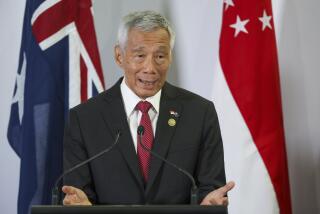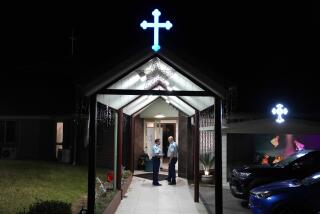U.S. Bolstering Mexican Military, Report Says
Smarting over its defeat by American military invaders in the 19th century, Mexico for years kept its relations with the U.S. armed forces to a bare, polite minimum. But the war on drugs has changed all that. Mexico is now one of the main recipients of U.S. military assistance in Latin America, a coalition of nongovernmental organizations reported Tuesday.
In 1997, Mexico received more U.S. money--more than $1 million--than any other country in Latin America to send its service personnel for training in the United States. A fact that would probably shock Mexican critics of the United States is that Mexican soldiers made up a third of the student body at the controversial U.S. Army School of the Americas in Fort Benning, Ga.
Atop this, Mexico ranked No. 3 in Latin America in purchases of U.S. arms and other defense equipment in 1997 and received more Pentagon money for anti-drug warfare than any other country except Colombia.
For Latin America as a whole, U.S. military assistance came to at least $260 million in 1997, Adam Isacson of the Center for International Policy, co-author of the report, told a news conference here.
Isacson and Joy Olson, the report’s other author and director of the coalition known as the Latin America Working Group, said 56,000 American service members worked, conducted training or took part in joint exercises on Latin American and Caribbean soil in 1997.
The rancor over American intervention is still so great, however, that while Mexico is willing to let its soldiers train in the United States, it does not want U.S. military instructors or joint exercises on Mexican soil.
“Any perception that we are on Mexico, in it or through it is not welcome,” a senior Defense Department official said recently. “Say the word ‘joint,’ and they have a heart attack.”
In their survey of U.S. military assistance to Latin America, Olson said, the researchers were surprised in three ways. “It was bigger than we thought,” she said, “more fragmented than we thought and worse than we thought in lack of congressional oversight.”
But Isacson acknowledged that the total assistance, while larger than anticipated, still does not match the large amount of military aid sent to Central America in the 1980s, when guerrilla wars raged in that region. And the aid has shifted, he said, from Central America to countries involved in the anti-narcotics war such as Colombia, Peru and Mexico.
The statistics about the training of Mexicans by Americans reveal a surprising and close relationship between the two military establishments. According to the report, 305 Mexican soldiers attended the Army’s School of the Americas in 1997. Chile was No. 2 with 145 soldier students.
The school, formerly based in the Panama Canal Zone, developed a notoriety in the 1980s after several of its officer graduates were later accused of human rights abuses. Defense Department officials, however, say the curriculum now includes courses on democracy and safeguarding human rights.
Mexico had 260 students at the Inter-American Air Force Academy at Lackland Air Force Base, Texas, in 1997, or almost 30% of the students last year. Colombia was second with 128 students.
Under a separate program within the State Department’s foreign operations budget, Mexico also received more than $1 million to send 192 military personnel for training at various other U.S. military institutions in 1997.
Although details about the extent of the U.S. military program in Latin America are not widely known, they are not secret.
But Olson and Isacson insist that the details are difficult to obtain because military assistance comes from numerous sources in the U.S. government, especially from different parts of the Defense Department.
“There are three dozen programs, agencies and spigots,” said Isacson. “It is difficult to get the big picture.”
The report, funded in part by the Ford Foundation, is an attempt to put that picture together.
The difficulty in obtaining information was not “nefarious,” Olson said, but stemmed instead from the numerous laws and agencies involved in military aid and the fact that the defense budget is so huge that details get lost in it.
The administration should be required to issue an annual report to Congress listing all the details of its military assistance programs, Olson said. She and Isacson said they were taking no position on the value of the military assistance programs but that they want the public to know about their size and variety.
On the Internet, the report is at https://www.ciponline.org/facts/
More to Read
Start your day right
Sign up for Essential California for news, features and recommendations from the L.A. Times and beyond in your inbox six days a week.
You may occasionally receive promotional content from the Los Angeles Times.






